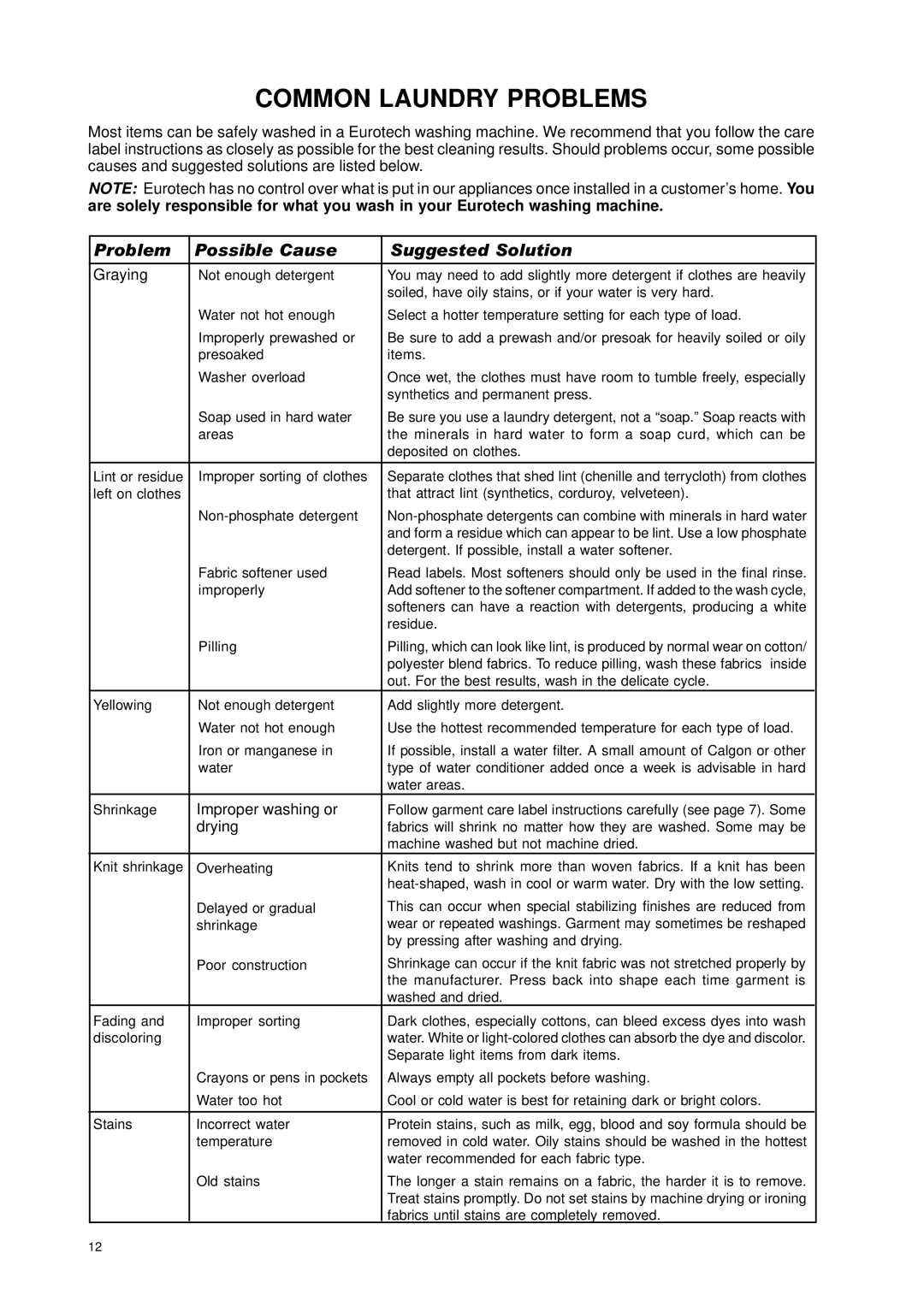COMMON LAUNDRY PROBLEMS
Most items can be safely washed in a Eurotech washing machine. We recommend that you follow the care label instructions as closely as possible for the best cleaning results. Should problems occur, some possible causes and suggested solutions are listed below.
NOTE: Eurotech has no control over what is put in our appliances once installed in a customer’s home. You are solely responsible for what you wash in your Eurotech washing machine.
Problem | Possible Cause | Suggested Solution |
|
|
|
Graying | Not enough detergent | You may need to add slightly more detergent if clothes are heavily |
|
| soiled, have oily stains, or if your water is very hard. |
| Water not hot enough | Select a hotter temperature setting for each type of load. |
| Improperly prewashed or | Be sure to add a prewash and/or presoak for heavily soiled or oily |
| presoaked | items. |
| Washer overload | Once wet, the clothes must have room to tumble freely, especially |
|
| synthetics and permanent press. |
| Soap used in hard water | Be sure you use a laundry detergent, not a “soap.” Soap reacts with |
| areas | the minerals in hard water to form a soap curd, which can be |
|
| deposited on clothes. |
|
|
|
Lint or residue | Improper sorting of clothes | Separate clothes that shed lint (chenille and terrycloth) from clothes |
left on clothes |
| that attract lint (synthetics, corduroy, velveteen). |
| ||
|
| and form a residue which can appear to be lint. Use a low phosphate |
|
| detergent. If possible, install a water softener. |
| Fabric softener used | Read labels. Most softeners should only be used in the final rinse. |
| improperly | Add softener to the softener compartment. If added to the wash cycle, |
|
| softeners can have a reaction with detergents, producing a white |
|
| residue. |
| Pilling | Pilling, which can look like lint, is produced by normal wear on cotton/ |
|
| polyester blend fabrics. To reduce pilling, wash these fabrics inside |
|
| out. For the best results, wash in the delicate cycle. |
Yellowing | Not enough detergent | Add slightly more detergent. |
| Water not hot enough | Use the hottest recommended temperature for each type of load. |
| Iron or manganese in | If possible, install a water filter. A small amount of Calgon or other |
| water | type of water conditioner added once a week is advisable in hard |
|
| water areas. |
Shrinkage | Improper washing or | Follow garment care label instructions carefully (see page 7). Some |
| drying | fabrics will shrink no matter how they are washed. Some may be |
|
| machine washed but not machine dried. |
Knit shrinkage | Overheating | Knits tend to shrink more than woven fabrics. If a knit has been |
|
| |
| Delayed or gradual | This can occur when special stabilizing finishes are reduced from |
| shrinkage | wear or repeated washings. Garment may sometimes be reshaped |
|
| by pressing after washing and drying. |
| Poor construction | Shrinkage can occur if the knit fabric was not stretched properly by |
|
| the manufacturer. Press back into shape each time garment is |
|
| washed and dried. |
Fading and | Improper sorting | Dark clothes, especially cottons, can bleed excess dyes into wash |
discoloring |
| water. White or |
|
| Separate light items from dark items. |
| Crayons or pens in pockets | Always empty all pockets before washing. |
| Water too hot | Cool or cold water is best for retaining dark or bright colors. |
|
|
|
Stains | Incorrect water | Protein stains, such as milk, egg, blood and soy formula should be |
| temperature | removed in cold water. Oily stains should be washed in the hottest |
|
| water recommended for each fabric type. |
| Old stains | The longer a stain remains on a fabric, the harder it is to remove. |
|
| Treat stains promptly. Do not set stains by machine drying or ironing |
|
| fabrics until stains are completely removed. |
12
